Haleem
Haleem is a type of stew popular in the Middle East, Central Asia, and Pakistan. Although the dish varies from region to region, it optionally includes wheat or barley, meat and lentils. Popular variations include keşkek in Turkey, Iran, Afghanistan, Tajikistan, Uzbekistan, Azerbaijan and northern Iraq; Hareesa in the Arab world and Armenia; Halim in Bangladesh and Pakistan; Khichra in Pakistan and India.[2]
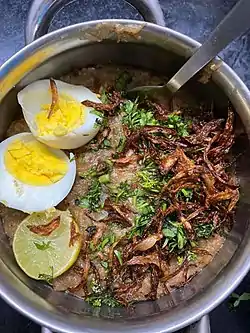 Indian Hyderabadi haleem garnished with fried onions, egg, cilantro, and lime. | |
| Place of origin | Pakistan[1][2] |
|---|---|
| Region or state | Central Asia Middle East South Asia |
| Main ingredients | Wheat, barley, lentils, meat |
| Variations | Hyderabadi haleem, Rampur Khichra, Harees |
Composition
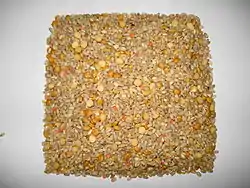
Haleem is made of wheat, barley, meat: usually minced beef or mutton; goat meat; or Lamb and mutton; or chicken, lentils and spices. Sometimes rice is also used. This dish is slow cooked for seven to eight hours, which results in a paste-like consistency, blending the flavors of spices, meat, barley and wheat.
Origin
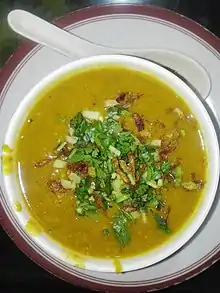
The origin of Haleem lies in the popular Arabian dish known as Harees (also written as Jareesh). According to Shoaib Daniyal, writing in The Sunday Guardian, the first written recipe of Harees dates back to the 10th century, when Arab scribe Abu Muhammad al-Muzaffar ibn Sayyar compiled a cookbook of dishes popular with the "kings and caliphs and lords and leaders" of Baghdad. "The version described in his Kitab Al-Tabikh (Book of Recipes), the world’s oldest surviving Arabic cookbook, is strikingly similar to the one people in the Middle East eat to this day" it reported. The Harees was cooked as the Arab empire was extended to different parts of the world.
Harees was introduced in the Indian subcontinent by the Arab soldiers of the Hyderabad Nizam's army to the city.[2][3][4] Today, Harees is still available in the Arab quarter of Hyderabad, an area called Barkas, where the dish is called Jareesh.[2] Later on, the people of Hyderabad modified it to suit their palate thus creating modern haleem.[3]
Cultural history
Haleem is sold as a snack food in bazaars throughout the year. It is also a special dish prepared throughout the world during the Ramadan and Muharram months of the Muslim Hijri calendar, particularly among Pakistanis and Indian Muslims.[5][6]
In India, haleem prepared in Hyderabad during the Ramadan month, is transported all over the world through a special courier service. Haleem is traditionally cooked in large, wood-fired cauldrons.[7]
Haleem is also very popular in Bangladesh, especially during the holy month of Ramadan, when it is a staple dish.[8][9]
In Pakistan, Haleem is available all year round, as well as in most Pakistani restaurants around the world. Haleem is sold as a snack food and street food in Pakistani bazaars throughout the year.[10][11]
Hyderabadi haleem
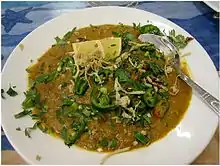
Haleem has become a popular dish in the cities of Hyderabad, Telangana and Aurangabad, Maharashtra (Aurangabad, the first capital of Hyderabad State) in India. Originating from an Arabic dish called Harees,[12] Haleem was introduced to the region during the Mughal period by foreign migrants.[13]
Khichra
In the Indian subcontinent, both haleem and khichra are made with same ingredients. In khichra, the chunks of meat remain as cubes, while in haleem the meat cubes are taken out of the pot, bones are removed, meat is crushed and put back in the pot. It is further cooked until the meat completely blends with the lentils, wheat and barley mixture.
 Haleem
Haleem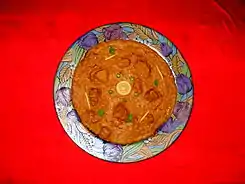 Khichra
Khichra
Preparation
A traditional haleem is made by firstly soaking wheat, barley and gram lentil overnight. A spicy meat gravy called Korma is prepared until the meat becomes tender. The wheat, barley and gram are boiled in salt water until they are tender. The cooked wheat, barley and lentils are then mixed with the meat (Beef or Mutton or Chicken) gravy and blended with a heavy hand mixer to obtain a paste-like consistency. The cooking procedure takes about 6 hours to complete. In the end the cooked haleem is garnished with fried onions, julienne cut ginger, sliced green chillies, coriander leaves, lemon wedges and chaat masala. However, haleem preparation varies in different regions.
Nutrition
A high-calorie dish, haleem provides protein from the meat and fibre and carbohydrates from the various combinations of grains and pulses.
Serving
Haleem can be served with chopped mint leaves, lemon juice, coriander leaves, fried onions, chopped ginger root or green chilies. In some regions of Pakistan, Haleem is eaten with Naan or with any type of bread or rice.
See also
| Wikibooks Cookbook has a recipe/module on |
- List of stews
- List of Pakistani soups and stews
 Food portal
Food portal
References
- "The haleem debate: Why some Muslims are renaming the Ramzan delicacy 'daleem'". scroll. Retrieved 29 October 2020.
- Daniyal, Shoaib (23 July 2014). "The history of haleem". The Sunday Guardian.
- "A culinary history of Haleem". The Times of India.
- Ihsaan Abrahams. "Haleem". Islamic Focus. Retrieved 28 November 2014.
- "Haleem recipe: The ingredient to refreshing old memories". The Express Tribune. Karachi. Retrieved 14 July 2015.
- Srinivas, M. "City in for flavours of Haleem". The Hindu. Retrieved 14 July 2015.
- "In Hyderabad this Ramzan? Don't miss the Haleem!". Rediff. 18 August 2010. Retrieved 28 November 2014.
- Khan, Arman R.; Mustabina, Labiba. "Iftar Offers You Can't Refuse". The Daily Star. Retrieved 14 July 2015.
- "Celebrate Ramadan at Khazana". The Daily Star. Retrieved 14 July 2015.
- "Best Haleem in town". The Express Tribune. Karachi.
- "The ultimate guide to: The best desi food in Karachi". Dawn.
- "The haleem debate: Why some Indian Muslims are renaming the Ramzan delicacy 'daleem'".
- Alikhan, Anvar. "How haleem became the new biryani". The Times of India. Bennett, Coleman & Co. Ltd. Retrieved 14 July 2015.
Further reading
| Wikimedia Commons has media related to Haleem. |
- Karan, Pratibha (1998). A Princely Legacy, Hyderabadi Cuisine. New Delhi: HarperCollins. ISBN 978-81-7223-318-1.
